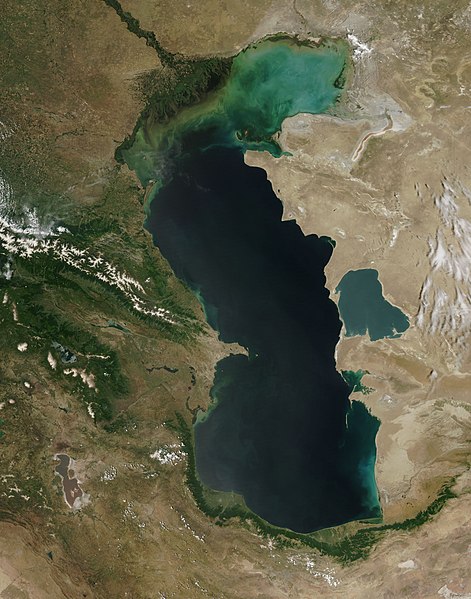Tugna:Caspian Sea from orbit.jpg

Tiddi n azaraskan agi : 471 × 599 iferdisen n tugna. Tibuda nniḍen : 188 × 240 iferdisen n tugna | 377 × 480 iferdisen n tugna | 603 × 768 iferdisen n tugna | 804 × 1 024 iferdisen n tugna | 1 609 × 2 048 iferdisen n tugna | 4 400 × 5 600 iferdisen n tugna.
Afaylu aneṣli (4 400 × 5 600 pixel, tiddi n ufaylu: 3,44 MB/MO, anaw n MIME: image/jpeg)
Amazray n ufaylu
Senned ɣef yiwen azmez d usrag iwakken ad ẓṛeḍ afaylu aken yella deg imir nni.
| Azemz/Ssaɛa | Aqmamaḍ | Iseggiwen | Amseqdac | Awennit | |
|---|---|---|---|---|---|
| Lux a | 14 Yunyu 2010 à 09:16 |  | 4 400 × 5 600 (3,44 MB/MO) | Originalwana | higher res |
| 8 Fuṛaṛ 2005 à 15:10 |  | 550 × 700 (67 KB/KO) | Pixeltoo | Caspian sea by space Nasa |
Aseqdec n ufaylu
Ulaḥedd seg isebtar sɛan azday ar afaylu-agi.
Aseqdec n ufaylu amatu
Iwikiyen-agi-nniḍen seqdacen afaylu-agi:
- Aseqdec ɣef af.wikipedia.org
- Aseqdec ɣef als.wikipedia.org
- Aseqdec ɣef am.wikipedia.org
- Aseqdec ɣef ang.wikipedia.org
- Aseqdec ɣef an.wikipedia.org
- Aseqdec ɣef arc.wikipedia.org
- Aseqdec ɣef ar.wikipedia.org
- بحر قزوين
- ويكيبيديا:صور مختارة/الفضاء والكون/نظرة إلى الخلف
- ويكيبيديا:ترشيحات الصور المختارة/بحر قزوين
- ويكيبيديا:صورة اليوم المختارة/ديسمبر 2016
- قالب:صورة اليوم المختارة/2016-12-23
- مستخدم:قائمة أكبر البحيرات والبحار في المجموعة الشمسية
- ويكيبيديا:صورة اليوم المختارة/يوليو 2020
- قالب:صورة اليوم المختارة/2020-07-16
- ويكيبيديا:صورة اليوم المختارة/يوليو 2023
- قالب:صورة اليوم المختارة/2023-07-26
- Aseqdec ɣef arz.wikipedia.org
- Aseqdec ɣef ast.wikipedia.org
- Aseqdec ɣef as.wikipedia.org
- Aseqdec ɣef av.wikipedia.org
- Aseqdec ɣef azb.wikipedia.org
- Aseqdec ɣef az.wikipedia.org
- Aseqdec ɣef bat-smg.wikipedia.org
- Aseqdec ɣef be.wikipedia.org
- Aseqdec ɣef bg.wikipedia.org
- Aseqdec ɣef bh.wikipedia.org
- Aseqdec ɣef bn.wikipedia.org
- Aseqdec ɣef br.wikipedia.org
- Aseqdec ɣef bs.wikipedia.org
- Aseqdec ɣef bxr.wikipedia.org
- Aseqdec ɣef ca.wikipedia.org
- Aseqdec ɣef ce.wikipedia.org
- Aseqdec ɣef ckb.wikipedia.org
- Aseqdec ɣef co.wikipedia.org
- Aseqdec ɣef cs.wikipedia.org
Wali l’utilisation globale n ufaylu-agi.



